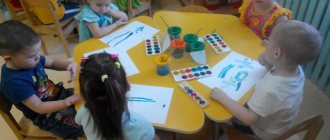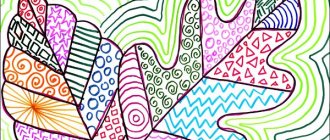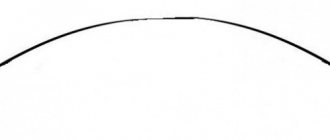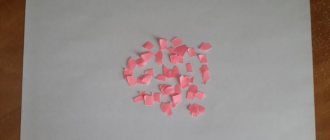MAGAZINE Preschooler.RF
Project “My funny ringing ball”Authors:
- Solovyova Svetlana Leonidovna,
- Neustroyeva Natalya Agitovna,
Teacher of MBDOU D/s No. 52 “Belochka, Yakutsk
Problem: Superficial interest of parents and children in the ball and playing with them.
Project goal: Creating conditions for children's motor activity through outdoor games with a ball. Acquaintance with the history of the ball and its varieties.
Project objectives: 1. To introduce children to the history of the ball and its varieties. 2. increase the motor activity of children through outdoor games with a ball. 3. Maintain children's interest in physical exercise and sports.
Project participation: Children of the middle group. Parents. Educators. Physical education instructor.
Duration of the project: short-term, educational.
Project type: Creative. Practice-oriented. Group. Short.
Expected results: Exhibition of balls made by parents. Expanding children's horizons about the history of the ball and its varieties. Improve your ball playing skills. Practice catching and passing the ball. Making a card index of outdoor games with a ball. Creating a folder about the types of ball, about the history of the ball. Folders “My funny ringing ball..” (contains the history of the ball, data on modern balls, recommendations for parents on choosing a ball for children, the meaning of the ball for a child, exercises with the ball, card files of games with the ball.
Relevance of the chosen topic: Preschool age is an important period in the formation of human personality and strong foundations of physical health. It is at this age that the foundations of physical development are laid, motor skills are formed, and the foundation for the development of physical qualities is created. Nowadays, children increasingly begin to spend their free time near the TV or computer. Therefore, there is a decrease in physical activity in children, which negatively affects health. In order to motivate children to engage in physical exercises and sports, it is necessary to teach them to play a variety of ball games. The ball is one of the most accessible sports equipment and every child has it. If a child has the necessary knowledge and skills, he will be able to independently organize ball games in the future. Ball games develop the eye, coordination, ingenuity, and promote general motor activity. For a child, a ball is a hobby from the first years of life. The child does not just play with the ball, but varies it: picks it up, carries it, puts it down, throws it, rolls it, etc., which develops him emotionally and physically. ball games - special complex gymnastics: develops the ability to grasp, hold, and move the ball while walking, running or jumping.
Games and exercises with the ball develop orientation in space, regulate the strength and accuracy of the throw, develop the eye, dexterity, and speed of reaction; normalize the emotional-volitional sphere, which is especially important for both sedentary and hyperexcitable children. Ball games develop muscle strength, strengthen the functioning of the most important organs of the body - lungs, heart, and improve metabolism.
Project implementation stages:
I.Preparatory:
- Making a card index “Outdoor games with a ball” .
- Creating a multimedia presentation for children on the topic: History of the ball”, “Varieties of balls” .
- Selection and design of demonstration material for children.
- Making a card index of outdoor games with a ball.
- Creating a folder about the types of ball, about the history of the ball. 6. Folders “My funny ringing ball..” (contains the history of the ball, data on modern balls, recommendations for parents on choosing a ball for children, the meaning of the ball for a child, exercises with the ball, card files of games with the ball).
II. Basic.
- Conversations with children on this topic.
- Learning poems and riddles with children about balls.
- Conducting games with children. 4. Creation of an exhibition of appliqué and ball sculpting. 5. Parents making their own balls.
- Drawing on the theme “My funny ringing ball” .
III. Final.
1. Sports festival for children “The ball and I are very friendly . 2. Design of the exhibition “Such a different ball” : collection of balls, drawings, illustrations; card index of games, game exercises, sets of exercises with the ball.
3. Exhibition of drawings “My funny ringing ball” .
4. Summing up the project implementation.
Conclusions:
53% of the group’s families took part in the project. Parents and children expanded their horizons by getting acquainted with the history of the ball and its varieties. Children improved their work on improving health and developing physical qualities: agility, speed, strength, and the ability to concentrate on movements. Ability to use the ball in independent play activities, outdoor and sports games. Use the ball more actively at home. We purchased a variety of balls for the group. Children's motor activity increased during the day (due to the use of ball games). The children's performance with the ball has improved.
| Next > |
How to draw a ball with a pencil step by step
Drawing a soccer ball step by step is actually quite easy. Draw an even circle with a pencil.
A soccer ball is made up of pentagons and hexagons. Draw a pentagon in the center of the already created circle. See the picture below.
Next, from each corner of the pentagon, draw lines of equal length. Use a ruler if you have difficulty determining the length of the lines by eye.
The following picture shows how to draw a soccer ball next. From the end point of the line, draw two lines in different directions. Try to keep them the same length too.
The same must be done for the remaining lines coming from the pentagon.
There is very little left in drawing this lesson. We close the lines - we get hexagons. Study the following drawing carefully. You should end up with one pentagon with hexagons around it.
Then finish the drawing with lines going to the base of the circle. The text may seem complicated, but the pictures will tell you more - they clearly show how to draw a soccer ball. Study them carefully, and you should not have any difficulties in drawing.
Soccer ball drawn! Color the pentagons black as in the main drawing of the lesson!
Soccer ball in squares
Your ball's design doesn't have to start with a circle. Try to draw it from cells.
- You will need a notebook sheet in a box, as well as a pen or pencil.
Operating procedure:
- In the center, but slightly below the middle of the sheet, paint five cells horizontally.
- From the upper right corner of the resulting rectangle, draw two more cells diagonally.
- Go up a cell and draw one. Above and to the side, vertically shade two cells.
- Now step back and draw six squares vertically. Do the same on the other side and finish the top in the same way.
- At the top of the ball, shade five divisions in the right corner. In the top left draw seven cells.
- Draw thirteen cells in the right corner. Almost going down to the lower right part, sketch out eight cells.
- To the left, offset, draw twenty-one cells.
Now you know how easy it is to draw a soccer ball in the cells. After all, everything ingenious is simple.
Easy way
This method is suitable for those who want to learn a simple technique for drawing a ball.
You will need:
- White list,
- Black and gray crayons,
- Compass,
- Black marker.
Operating procedure:
- Place the sharp end of the compass in the middle of the sheet. Select the radius you need.
- Draw a circle. We outline the outline with a black marker.
- Approximately in the center of the drawn circle, draw one inclined line.
- From the bottom edge of this line, draw another segment directed to the right.
- From the end of the second segment, draw a line of the same size, but now upward.
- From the end of this line, draw another line and connect the pentagon.
- You have a figure that resembles a rhombus. From all the resulting corners, draw along a segment of identical length.
- From each edge, draw two segments in opposite directions.
- We connect the unfinished lines with segments to the contours of the main circle.
- Connect the unfinished sides with lines. Smaller figures are marked with a black marker along the outline.
- Now the main thing is to paint the ball correctly. Use black chalk to paint over the cells outlined with a marker.
- Here you need to be careful and not confuse the order of the cells being painted, otherwise the drawing will be distorted.
- Color in the remaining shapes with gray chalk.
You see how easy it is to draw a seemingly complex ornament of the main football attribute.
Pentagons
Draw pentagon shapes. Due to the round shape of the ball, pentagons throughout its entire surface visually look different from different angles.
All pieces must hit the same size. To do this, use a ruler.
Add lines to fully convey the “pattern” of the soccer ball.
5







